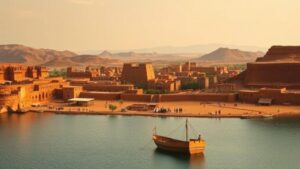Searching for the “Golden Gates of Eternity,” described in ancient scripts as guarding a city in Central Asia.
Searching for the Golden Gates of Eternity
The city referred to as the Golden Gates of Eternity has captivated historians, archaeologists, and adventurers alike. Ancient scripts describe this mythical destination as a guardian of treasures and secrets, said to be located in Central Asia. This article delves into the historical context, archaeological efforts, and ongoing fascination with this legendary city.
Historical Context
The legend of the Golden Gates of Eternity dates back thousands of years, weaving its roots into the tapestry of Central Asian culture. Many scholars believe that this mysterious city could be linked to the ancient Silk Road. This trade route, which flourished between the 2nd century BCE and the 14th century CE, fostered cultural exchanges and economic partnerships among Asia, the Middle East, and Europe.
Historical texts, such as those written by the Greek historian Ptolemy in the 2nd century CE, hint at the existence of prosperous cities in Central Asia, rich with luxury goods, gold, and knowledge. But, definitive evidence of the Golden Gates remains sparse, as scholars argue about the city’s exact location and whether it existed at all.
Archaeological Pursuits
Modern archaeological missions have sought to uncover the truth behind the Golden Gates. Initiatives in countries like Uzbekistan, Kazakhstan, and Turkmenistan have revealed numerous ancient sites, but none conclusively link to the fabled city. Notable archaeological sites such as Samarkand and Bukhara have been pivotal in providing context for the regions history.
One of the most significant discoveries came during excavations in the early 2000s near the ancient city of Khiva in Uzbekistan. Researchers unearthed artifacts, including intricate gold jewelry and pottery, dating back to the time of the Silk Road. Such finds fuel speculation that the Golden Gates of Eternity could be an allegorical representation of a prosperous civilization rather than a specific, physical location.
Legends and Theories
The intrigue surrounding the Golden Gates of Eternity is often amplified by local legends. Many stories describe a city surrounded by magnificent gates made of gold, shimmering in the sunlight. According to local folklore, the gates protect sacred knowledge and wealth from outsiders, ensuring that only the worthy may enter.
- The Legend of the Mysterious Gatekeepers: Some tales recount the presence of ethereal gatekeepers who guard the entrance to the city, only allowing entry to those who possess unparalleled wisdom.
- The Pathways of Light: Other stories suggest that the gates only reveal themselves during certain celestial events, such as solar eclipses or the solstices, drawing parallels to ancient practices of astrology.
Modern Applications
The search for the Golden Gates of Eternity has transcended historical inquiry and inspired modern explorations. Today, researchers and historians utilize cutting-edge technology like satellite imagery and ground-penetrating radar to explore potential locations of lost cities.
Also, the allure of the Golden Gates has extended into literature and the arts, influencing writers, filmmakers, and artists seeking to capture the essence of adventure and discovery. This reflects the continued relevance of ancient myths in contemporary culture.
Conclusion
The quest for the Golden Gates of Eternity embodies the timeless human desire for exploration and understanding of our history. As archaeologists continue to investigate Central Asia’s rich past, the legend of this mythical city inspires both academic pursuit and artistic expression.
While the physical gates may remain undiscovered, the stories and the search for knowledge they inspire endure, serving as a poignant reminder that history, both real and imagined, shapes our collective identity. Whether or not the Golden Gates of Eternity are ever found, their legacy is firmly etched in the annals of human curiosity and ambition.



